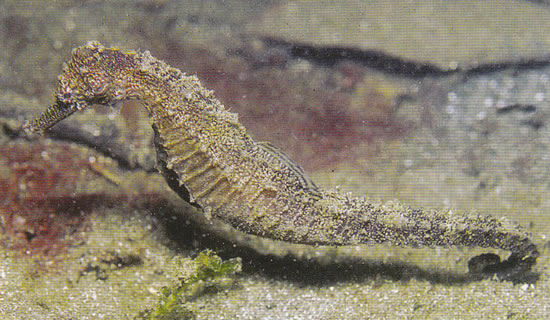- Classification
- ACTINOPTERYGII
- SYNGNATHIFORMES
- SYNGNATHIDAE
- Hippocampus
- kampylotrachelos
Smooth Seahorse, Hippocampus kampylotrachelos Bleeker 1854

A Smooth Seahorse, Hippocampus kampylotrachelos. Source: Rudie Kuiter / Aquatic Photographics. License: All rights reserved
A relatively smooth dusky brown to greyish seahorse with fine black and white spots and scribbles, and a poorly developed crown and coronet. The only Australian record of the Smooth Seahorse is a dried specimen found amongst nesting seabirds at Ashmore Reef off north Western Australia.
Smooth Seahorse, Hippocampus kampylotrachelos Bleeker 1854
More Info
|
Photo Rights |
A Ogawa |
|
Distribution |
Tropical Western Pacific from Sumatra, Bali and Ashmore Reef; benthic on muddy substrates in very sheltered estuaries, or in deep coastal waters, in 3-10 m. |
|
Features |
Meristic features: Dorsal fin 19; Anal fin 4; Pectoral fin 16; trunk rings 11; tail rings 39; subdorsal rings 2 + 1. |
|
Size |
Height to at least 22 cm |
|
Colour |
Overall dusky brownish grey to almost black, covered with fine white and black spots and scribbles, especially on head where these form a pattern radiating from eyes and lines along lower part of operculum; dorsal fin with two longitudinal lines, one marginally and one centrally. |
|
Feeding |
Like other seahorses, this species presumably feeds by sucking small crustaceans and other planktonic organisms into its mouth. |
|
Biology |
Males give birth to tiny independent young. The female uses an ovipositor to transfer her eggs into an elaborate enclosed pouch under the abdomen of the male. The male not only fertilizes the eggs inside the pouch and provides physical protection for the developing embryos, he also osmoregulates and aerates the embryos and may provide some nourishment until the offfspring are born. |
|
Fisheries |
None. There is no known trade in this species in the aquarium or Asian Traditional Medicine industries. |
|
Conservation |
International: Listed under Appendix II of the Convention on the International Trade in Endangered Species of Wild Flora and Fauna (CITES). As a result, the species is subject to the Convention, http://www.cites.org/. |
|
Remarks |
H. kampylotrachelos is known from very few specimens and is regarded as a synonym of H. trimaculatus by some authors. |
|
Similar Species |
None |
|
Etymology |
Hippocampus is from the Greek ippos = horse and kampe = curvature. The specific name kampylotrachelos is from the Greek kampe meaning caterpillar and trachelos meaning neck. |
|
Species Citation |
Hippocampus kampylotrachelos Bleeker 1854, Nat. Tijdschr. Ned. Ind. 7: 107, Priaman, Sumatra, Indonesia. |
|
Author |
Vanessa J. Thompson & Dianne J. Bray |
Smooth Seahorse, Hippocampus kampylotrachelos Bleeker 1854
References
Bleeker, P. 1854. Overzigt der ichthyologische fauna van Sumatra, met beschrijving van eenige nieuwe soorten. Natuurkd. Tijdschr. Neder. Indië 7: 49-108.
Hoese, D.F., D.J. Bray, J.R. Paxton & G.R. Allen. 2006. Fishes. In Beesley, P.L. & A. Wells. (eds.) Zoological catalogue of Australia. Volume 35. ABRS & CSIRO Publishing: Australia Part 1, 2178 pp.
Kuiter, R.H. 2001. Revision of the Australian Seahorse of the genus Hippocampus (Syngnathiformes: Syngnathidae) with descriptions of nine new species. Rec. Aust. Mus. 53: 293-340.
Kuiter, R.H. 2009. Seahorses and their relatives. Aquatic Photographics, Seaford, Australia, 333 p.
Lourie, S.A., A.C.J. Vincent & H.J. Hall. 1999. Seahorses: an identification guide to the world's species and their conservation. Project Seahorse. London, UK. 214 pp.
Pogonoski, J.J., D.A. Pollard & J.R. Paxton. 2002. Conservation Overview and Action Plan for Australian Threatened and Potentially Threatened Marine and Estuarine Fishes, Canberra, Environment Australia, 375 pp.


